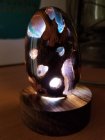Hello, all,
I would like to fill voids with epoxy – things like a knarly root ball, or wood with a lot of cracks in it, or a banksia pod. I'd like to submerse the item in epoxy to produce something that is ultimately solid, which I can then turn. (I currently have West system two-part epoxy. If that's not a good choice for this type of project, I'm happy to try something different next time. I'm just starting out with this, West happened to be the first thing I tried.)
To get rid of all the air inside voids like this, which would be better: a pressure pot, or a vacuum chamber? I have neither, so I'm trying to figure out which to invest in. I've been reading all the posts I can find on this topic, but the answer is not clear; lots of answers say "use a pressure pot or a vacuum chamber..." My question is which one is better for this particular use, and why?
So far, I've learned (among other things)
- pressure doesn't eliminate the air, just makes the bubbles invisible;
- a vacuum will bring bubbles to the surface;
- vacuum might take too long, if the set time is short.
If it turns out that a vacuum chamber is better:
I have a compressor, but not a vacuum pump. I'm guessing I can't use a shop vac... ;-) Could the compressor be used to create the vacuum without permanent modification?
Thanks for any advice!
--
anastasia
I would like to fill voids with epoxy – things like a knarly root ball, or wood with a lot of cracks in it, or a banksia pod. I'd like to submerse the item in epoxy to produce something that is ultimately solid, which I can then turn. (I currently have West system two-part epoxy. If that's not a good choice for this type of project, I'm happy to try something different next time. I'm just starting out with this, West happened to be the first thing I tried.)
To get rid of all the air inside voids like this, which would be better: a pressure pot, or a vacuum chamber? I have neither, so I'm trying to figure out which to invest in. I've been reading all the posts I can find on this topic, but the answer is not clear; lots of answers say "use a pressure pot or a vacuum chamber..." My question is which one is better for this particular use, and why?
So far, I've learned (among other things)
- pressure doesn't eliminate the air, just makes the bubbles invisible;
- a vacuum will bring bubbles to the surface;
- vacuum might take too long, if the set time is short.
If it turns out that a vacuum chamber is better:
I have a compressor, but not a vacuum pump. I'm guessing I can't use a shop vac... ;-) Could the compressor be used to create the vacuum without permanent modification?
Thanks for any advice!
--
anastasia

